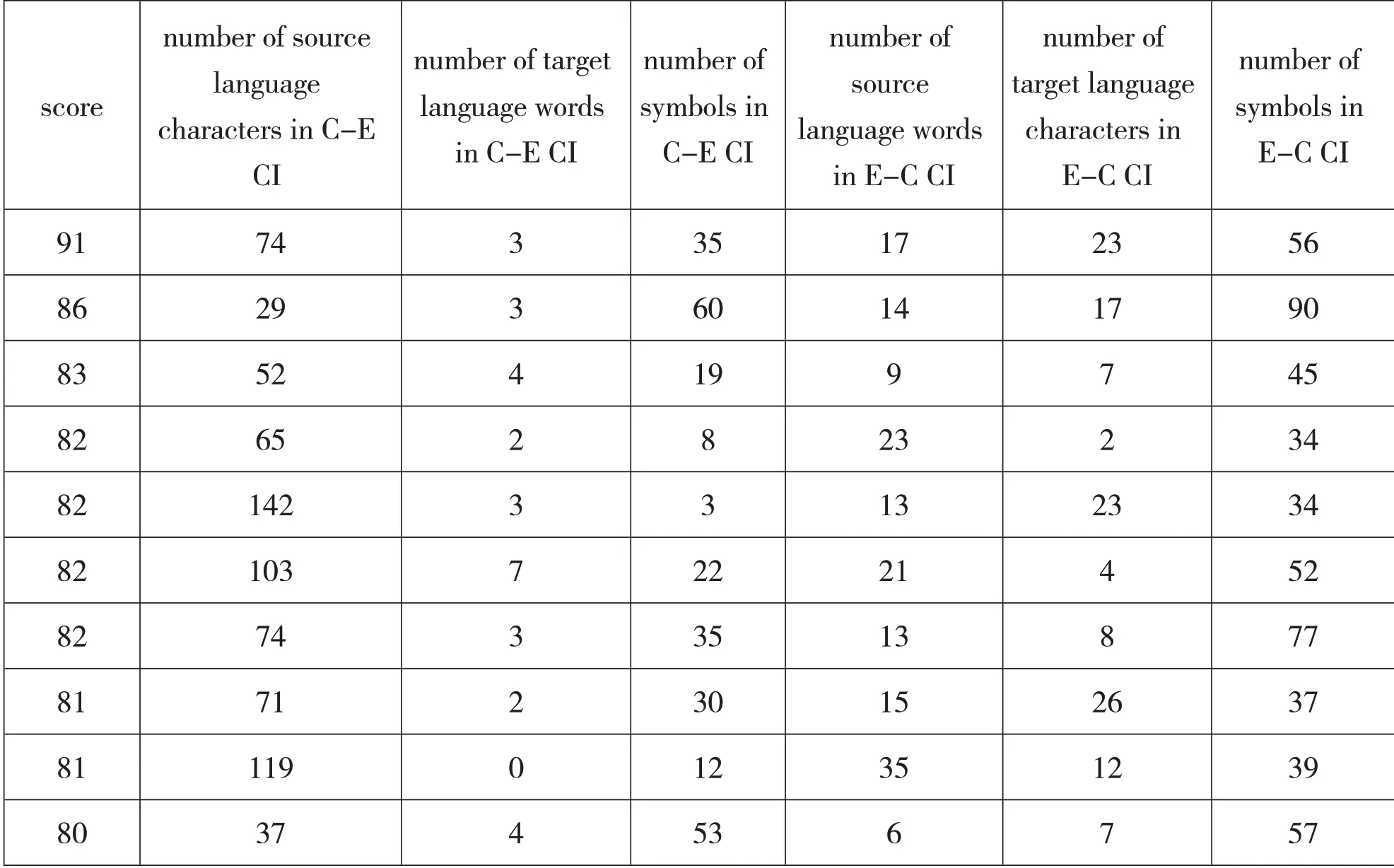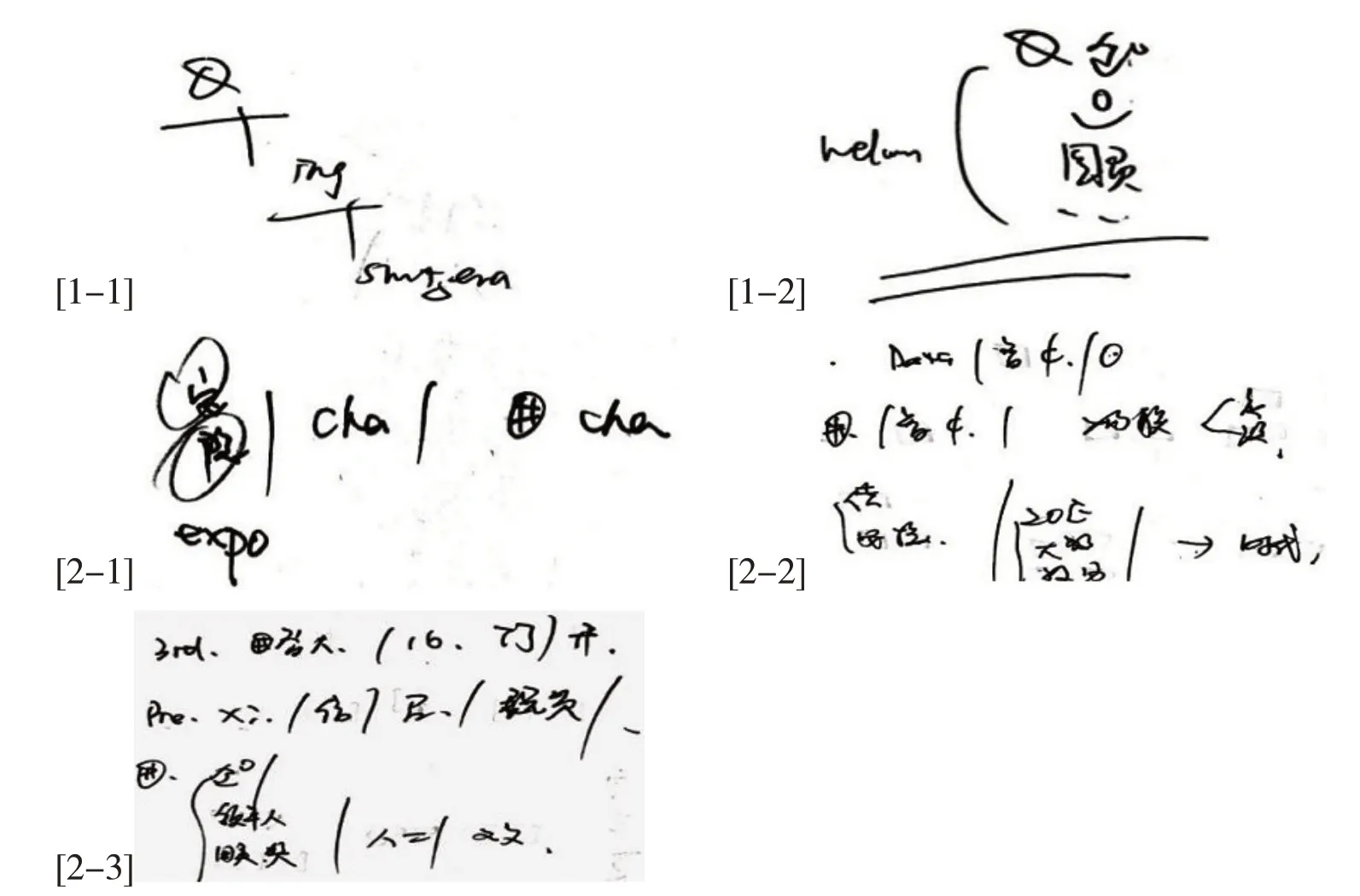ANALYSIS ON INFLUENCE OF NOTETAKING LANGUAGE AND SYMBOLS ON CONSECUTIVE INTERPRETATION PERFORMANCE
School of Foreign Languages,University of Electronic Science and Technology of China Email:longmei@uestc.edu.cn
[Abstract]Note-taking plays an essential role in consecutive interpretation(CI).This research takes 35 year-one MTI students as its subjects,and carries out an empirical analysis on the relations among choices of note-taking languages,numbers of symbols,and CI performances.The results show that choices of note-taking languages are confined by subjects’mother-tongue(i.e.Chinese)and their English proficiency,while the numbers of symbols and the internalization of symbols contribute to CI performances.
[Keywords]consecutive interpretation;note-taking language;source language;target language;symbols
INTRODUCTION
“Interpretation,from the source language to the target language,is not a straight line,but a dynamic process of understanding,analyzing,and expressing,which proceeds from the surface to the center and then all backwards”(Bao,2005,p.37).Peterson(1959)found out through experiments that“the longer each student had to count backwards,the less well they were able to recall the trigram accurately.After 3 seconds,80%of the trigrams were recalled correctly.After 6 seconds,this fell to 50%.After 18 seconds less than 10% of the trigrams were recalled correctly.”This proves the essentiality of note-taking in interpretation.Gillies(2009,pp.6-8)also pointed out three reasons for taking notes in consecutive interpretation:(1)for“macro-thinking.Notes taken in consecutive interpreting are a representation of the skeleton structure of the speech.”.(2)for better capacity.“Consecutive interpreting involves a number of different tasks that have to be completed at the same time with finite and competing intellectual capacities:multi-tasking.”,which involves“Phase 1:listening and analysis,note-taking,short-term memory operations,coordination of these tasks;Phase 2:note-reading,remembering,production”;(3)for automatization.“The application of a well-practiced and thought-out system will mean that the whole exercise of consecutive interpreting becomes less of an effort.”Therefore,improving the efficiency of note-taking plays a crucial role in effectively bettering the CI performance.Meanwhile,Gillies(2009,p.99)clarified the value of symbols for CI notes:compared with words,“symbols(1)are quicker and easier to write;(2)are easier to read on the page; and(3)represent concepts not words,they are not one-to-one translations so they help us avoid source language interference when we interpret.”He also noted that“A symbol doesn’t have to be a picture.It also can be a short word,pair of letters or a single letter.What is important is that it represents something.”(ibid.)
RESEARCH STATUS
Researchers of CI note-taking training have been trying to answers questions including“Which language used in note-taking helps trainees better understand the source language information on a macro-thinking level?”“Is the number of symbols used in note-taking directly proportional to CI capacity?”and“How to efficiently use the symbol system?”
Liu(2010)found out in the experiment on C-E CI notes that 120 year-four English major subjects used a huge amount of the source language for note-taking;Wang et.al(2010)carried out a study on 12 year-four English major subjects,which shows that the source language was the language they used for both C-E and E-C CI note-taking;Dai & Xu(2007)included 6 trainees with 3-month training experience and 6 year-four English major students as their subjects,and found out that their note-taking language was mainly the source language in C-E CI notes;while Zhang & Xu(2012)noticed the target language being their leading note-taking language in the experiment on C-E and E-C CI notes of 5 professional interpreters’and 5 MTI students’.He(2001)analyzed the C-E and E-C CI notes of students’and found out major differences in their way of taking notes;Yang(2006)compared the CI notes in their training and tests between two groups of subjects(totally 22 year-two English major students)and concluded that their efficient use of symbols and acronyms improved their interpretation performance.
The incoherence among domestic studies on note-taking language and symbols cannot provide theoretical guidance for CI note-taking teaching.
RESEARCH QUESTIONS
Based on relevant studies about CI note-taking language and symbol systems mentioned above,this research is to carry out analyses on the use of note-taking language and symbol systems in C-E and E-C CI test notes of some year-one MTI students,so as to explore the relations between the research results and their test scores.Three questions are raised for the research:(1)Does the choice of note-taking language affect subjects’interpretation test results?(2)Is the number of note-taking symbols used necessarily related to subjects’test results?(3)How can the research results inspire future interpretation note-taking teaching?
RESEARCH DESIGN
Subjects of this research are 35 year-one MTI students in a university in Sichuan Province.Ideally,they had acquired“Basic Interpretation”training in their undergraduate years and accumulated a certain amount of CI practice.Before the test was taken,they’d had 60 class hours of science-themed interpretation training.
This CI test was taken by all subjects at the same time in one language laboratory.The recording was played sentence by sentence,and during each pause,subjects delivered their interpretation and had them recorded simultaneously.The test included 5 Chinese sentences whose lengths were around 57-88 characters and which were read at the speed of 170 characters per minute(360 characters in total),as well as 14 English sentences whose lengths were around 16-38 words and which were read at the speed of 170 words per minute(353 words in total).The theme of this test was“information technology”,with“big data”,“IOT”,“smart city”,“AI”,“cloud computing”,and“Big Data Expo”as its key terms.Comparatively speaking,“petabyte”and“terabyte”are supposed to be two new terms for the subjects.All subjects’note manuscripts were collected right after the test was over,with the recordings saved,transcribed and analyzed.
The researcher assessed the 35 recordings and transcripts from four aspects,i.e.,completeness,accuracy,logical consistency,and fluency,and divided the subjects’scores into four categories,including 1 above 90,9 between 80 and 89,19 between 70 and 79,and 6 between 60 and 69.Afterwards,the numbers of source language characters/words,target language words/characters,and symbols were counted,and then the relativity of note manuscripts and test scores were analyzed.To highlight the contrast between the notes of subjects in the higher-score section(i.e.80-89 points and above 90 points)and those of subjects in the lower-score section(i.e.60-69 points),the notes of subjects in the medium-score section(i.e.70-79 points)were left out.
RESEARCH RESULTS AND DISCUSSION
The two tables below show the complete numbers of source language characters,target language words,and symbols(including figures,pictures,brackets,arrows,incomplete words or strokes and their combinations)in C-E CI notes and the total numbers of source language words,target language characters,and symbols in E-C CI notes,of all subjects’in these two score sections.

Table 1:Statistics of notes of subjects’in higher-score section

Table 2:Statistics of notes of subjects’in lower-score section

65 60 88 81 6 5 3 19 30 11 33 1 9 16
Table 1 shows the general phenomena in the notes of subjects’in the higher-score section:in the C-E CI notes,numbers of source language characters are almost two times of those of symbols(with few exceptions),while numbers of target language words are far fewer than the other two(esp.than the source language characters); in the E-C CI notes,numbers of source language words are almost the same as those of target language characters,while numbers of symbols are about two times of the other two.
Table 2 shows similar phenomena in the notes of subjects’in the lower-score section:in the C-E CI notes,numbers of target language words and symbols are close,yet numbers of source language characters are two times of the other two;in the E-C CI notes,there’s not much difference among the numbers of source language words,target language characters,and symbols(except for one note with a too low number of target language characters).
Comparison of two tables tells the obvious difference in note-taking between subjects in two score sections.In C-E CI notes,the numbers of source language characters in lower-score section are far bigger than those in the higher-score section,the numbers of target language words are close,while symbols are much more in the high-score section than those in the other one.In E-C CI notes,numbers of source language words are slightly bigger in the lowerscore section than those in the other section,numbers of target language characters are close(with a few exceptions),while symbols are still much more in the high-score section than those in the lower one.
Data analyses above prove that,(1)subjects are more inclined to use the combination of a large amount of mother language and a certain number of symbols in their C-E CI notes,in whichever score section,while the target language thinking is rarely utilized for note taking;(2)the target language(i.e.mother tongue)thinking is scarcely involved in E-C CI note-taking,yet subjects in the higher-score section may make better use of the convertibility between the source language and symbols,therefore,more symbols in their notes;(3)the efficient use of symbols is positively proportional to subjects’interpretation test results.
The following fragments are some of the note manuscripts of subjects’in the lower-score section:

The similar factors among these notes are:(1)there’s hardly any words of the target language or symbols while the number of source language characters are shockingly big;(2)most of such characters(e.g.“第三屆”,“祝賀”,“華為”,“人工智能”,and“城市發(fā)展”,etc.)as well as very few target language words(e.g.“minimize”)can be omitted or replaced with symbols.Such notes are obviously restricted by source language thinking,resulting in rather a low note-taking efficiency.
The following fragments are some notes on one same E-C sentence taken by subjects of the lower-score section:

These fragments reflect obviously low language capacity of subjects’in the lower-score section,when receiving the source language information which suffered huge losses(e.g.the anticipated new terms,“terabyte”and“petabyte”turned out to be new terms indeed,and“Tony Ma”,a famous person’s name was missing).Besides,these subjects were trying to take down as many source language words as possible(e.g.the most frequently noted“Big Data”,and words like“a”and“day”)and were over-converting source language words into target language characters instead of using symbols(e.g.“儲(chǔ)存中心”).
The following two groups of fragments are C-E and E-C note manuscripts of two subjects’who got highest scores in the test.

It’s obvious that these two subjects with highest scores share many features in their notes,both in C-E CI and E-C CI:(1)the formats adhere to the widely suggested norm for CI note-taking,and the layouts show efficient information chunks;(2)dividing or connecting lines are drawn for macro-thinking;and(3)abundant symbols and relatively internalized symbol systems(e.g.repetitive use of symbols for“world”and“city”,etc.).The obvious difference between their notes is about the choices of note-taking language.
CONCLUSION AND INSPIRATION
The conclusion drawn based on the analyses of C-E and E-C CI notes of subjects’in two score sections shows,(1)in both sections,subjects incline to adopt the mother tongue(i.e.Chinese)plus symbols in C-E CI note-taking,while the target language is rarely their choice,although their target language(i.e.English)proficiency impacts their recognition of notes and their performances;(2)the target language(i.e.Chinese)is scarcely adopted for notes understanding,while subjects in the higher-score section make better use of the convertibility between source language(i.e.English)and symbols and the proportion of symbols in their notes is higher than that of students’in lower-score section;(3)the efficiency of using symbols is directly proportional to subjects’interpretation performance;and(4)notes and performance of subjects’in lower-score section is impacted by their lower listening comprehension capacity.
This research inspires CI teaching in aspects as follows,(1)laying a solid language foundation is the key to earlier stages of interpretation training as well as a never ceasing task;(2)in C-E CI training,unification of symbols and internalization of symbol systems is to be emphasized for weakening of mother tongue reliance,so as to simplify notes and more efficiently take notes;(3)in E-C CI training,the convertibility between source language and symbols may be utilized for internalizing symbol systems and enhancing note-taking efficiency.
Due to the limited number of subjects and of sentences for the test,the conclusion of this research may not be strong enough.Hopefully,there would be more subjects on diverse levels involved and more researches carried out,so as to advance the development of CI teaching in China.
 Proceedings of Northeast Asia International Symposium on Linguistics,Literature and Teaching2020年0期
Proceedings of Northeast Asia International Symposium on Linguistics,Literature and Teaching2020年0期
- Proceedings of Northeast Asia International Symposium on Linguistics,Literature and Teaching的其它文章
- Language Assessment Literacy and the Influential Factors:Evidence from a Survey of Middle School English Teachers in Chongqing
- Case Study:Interviewing,Assessing,and Analyzing a Second Language Learner
- A Comparative Study on the Effects of Two Modes of Internet-based Feedback in EFL Writing Settings
- A Corpus-based Study on Conceptual Metaphor in T.S.Eliot’s Four Quartets
- Exploration of the SPOC-based Blended Teaching Model:Case Study of Business English Course
- The Study on CET-4 Writing and Writing Teaching Strategies Based on the Survey of CET-4 Writing Marking Teachers
